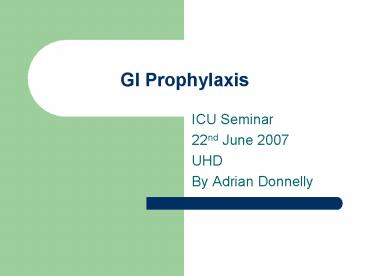GI Prophylaxis - PowerPoint PPT Presentation
1 / 24
Title:
GI Prophylaxis
Description:
Enteral nutrition and ranitidine protect against bleeding, and an additive effect is seen. ... Enteral Nutrition ... results for enteral feeding being used ... – PowerPoint PPT presentation
Number of Views:286
Avg rating:3.0/5.0
Title: GI Prophylaxis
1
GI Prophylaxis
- ICU Seminar
- 22nd June 2007
- UHD
- By Adrian Donnelly
2
Introduction
- 1832 Cushing reported ulcer disease associated
with surgery and trauma - 1842 Curling described a series of severe
duodenal ulceration associated with burns - Strong association with severe illness and
incidence of GI bleeds have been established - Major bleeds have a high mortality rate
- Prophylaxis now a central ICU issue
3
What is Stress Ulceration?
- Gastrointestinal mucosal injury related to
critical illness - Incidence related to severity illness 1
- Not related to H.pylori or existing peptic ulcer
- Multifactorial
- Hypoperfusion
- Loss of host defences
4
Why is it important
- Mortality with bleeding extremely high
- 48.5 2
- 87.5 3
- This poor outcome probably a reflection of
patients severity of illness rather than bleed
itself
5
What causes it?
6
What causes it?
- Damaged mucosa
- Reduced mucosal blood flow
- Leads to
- Reduced prostaglandins
- Mucosal Atrophy
- Increased permeability
- Loss of ability to neutralise H ions
- Loss of reparative ability
7
Risk factors
- 2 studies by Cookes group 2,4
- Respiratory failure
- Coagulopathy
- Sepsis
- Liver failure
- Hypotension
- Renal Failure
- Duration of Stay
- Multiple of above risk factors(burns)
8
Incidence
- Incidence and Prevalence reducing
- 1970s and 1980s 15 5
- Cooke et al- 1.5 clinically significant 2
- Incidence associated with
- Severity of illness
- Patient factors
- Duration ventilation
- Duration of ICU stay
9
Treatment
- Antacid
- Sucrulfate
- H2RA
- PPI
- Enteral nutrition
- General Measures
10
Cook et al JAMA 1996
11
Cook DJ et al New Eng j 1998
12
Treatment
- Evidence suggests that bleeding, but not
mortality can be reduced, by all agents. 7 - Evidence suggests that H2 receptor antagonists
are most efficient in reducing overt and
clinically important bleeding in ICU patients.
4 - Enteral nutrition and ranitidine protect against
bleeding, and an additive effect is seen. 8
13
PPI
- Effectively suppresses gastric pH levels in the
ICU patient - PPIs superior to H2RAs for PUD and GRD
- Data extrapolated in SRMB
- Omeprazole found to be superior than ranitidine
in preventing SRMB9 - Groups not equal regarding risk
14
PPI
- Several studies concluded agents were safe and as
effective as an alternative to H2RA - Small studies
- Need for further clinical trials
15
Enteral Nutrition
- Cook et al protective effect of enteral feeding
for prevention SRMB (relative risk 0.30)8 - Inconclusive results for enteral feeding being
used as SUP9 - Cannot be recommended as sole agent10
16
Treatment Strategy
- No current evidence that patients without 1 of 6
major risk factors warrant prophylaxis - Shock
- Sepsis
- Resp failure
- Hepatic failure
- Renal failure
- Coagulopathy
17
Treatment Complications
- Nosocomial pneumonia
- Anti-acid therapy promotes colonisation of gut
mucosa - Aspiration may cause pneumonia 611
- Sucralfate doesnt alter gastric pH
- Pnuemonia rates with ranitidine and sucralfate
not statistically different12
18
Treatment Complications
- Nosocomial pneumonia H2RA vs PPI
- 14 patients on ranitidine developed NP
- 3 patients on omeprazole developed NP 13
19
Discussion and Questions
20
References
- 1 - Pruitt BA, Jr., Foley FD, Moncrief JA.
Curling's ulcer a clinical-pathology study of
323 cases. Ann Surg 1970 172(4)523-539. - 2 Cook DJ, Fuller HD, Guyatt GH, Marshall JC,
Leasa D, Hall R et al. Risk factors for
gastrointestinal bleeding in critically ill
patients. Canadian Critical Care Trials Group. N
Engl J Med 1994 330(6)377-381.
21
References
- 3 Skillman JJ, Bushnell LS, Goldman H, Silen
W. Respiratory failure, hypotension, sepsis, and
jaundice. A clinical syndrome associated with
lethal hemorrhage from acute stress ulceration of
the stomach. Am J Surg 1969 117(4)523-530. - 4 Cook D, Guyatt G, Marshall J, Leasa D, Fuller
H, Hall R et al. A comparison of sucralfate and
ranitidine for the prevention of upper
gastrointestinal bleeding in patients requiring
mechanical ventilation. Canadian Critical Care
Trials Group. N Engl J Med 1998 338(12)791-797.
22
References
- 5 Shuman RB, Schuster DP, Zuckerman GR.
Prophylactic therapy for stress ulcer bleeding a
reappraisal. Ann Intern Med 1987 106(4)562-567. - 6 Cook DJ, Walter SD, Cook RJ, Griffith LE,
Guyatt GH, Leasa D et al. Incidence of and risk
factors for ventilator-associated pneumonia in
critically ill patients. Ann Intern Med 1998
129(6)433-440.
23
References
- 7 Cook DJ et al JAMA 1996
- 8 Cook DJ et al. Crit Care Med 1999 272812
- 9 Raff et al Burns 1997 23313-318
- 10 MacClaren et al Use of enteral nutrition
for stress ulcer prophylaxis. Ann Pharmacother
2001351614-1623 - 11 Tryba role of acid suppressants in
intensive care medicine. Best Pract Res Clin
Gastroenterol
24
References
- 12 Tryba M Sucalfate vs antacids or H2RA for
SUP A meta-analysis on efficacy and pneumonia
rate. Crit Care Med 19901644-49 - 13 Levy et al Comparison of omeprazole and
ranitidine for SUP Dig Dis Sci 1997 421255-1259































